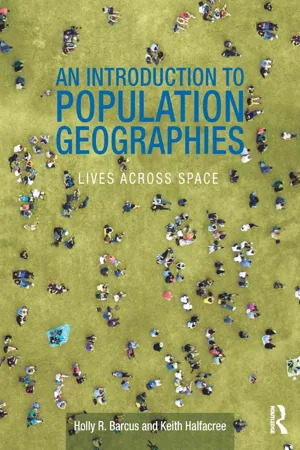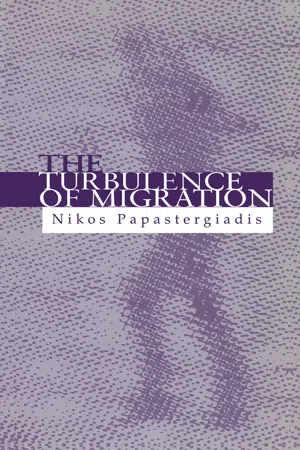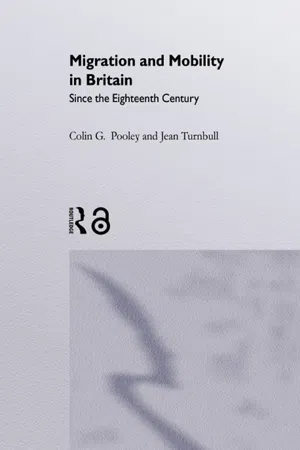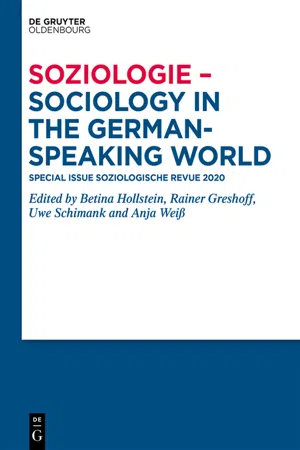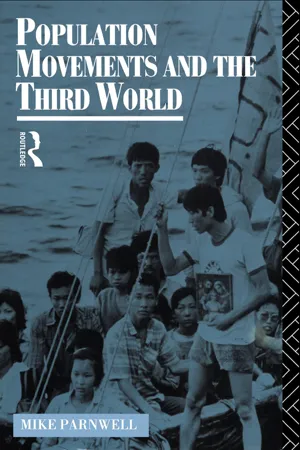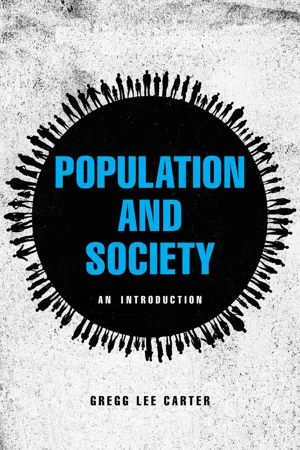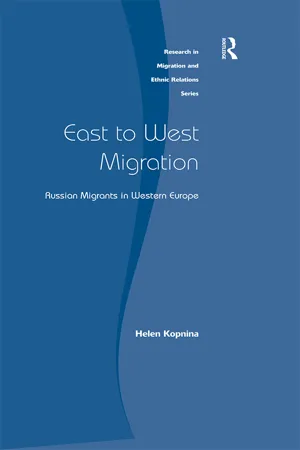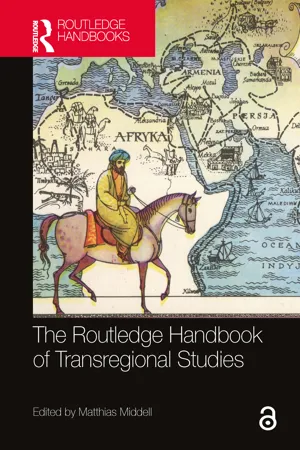History
Migration
Migration refers to the movement of people from one place to another, often in search of better living conditions, opportunities, or to escape hardship. Throughout history, migration has been a significant factor in shaping societies, cultures, and economies. It has led to the exchange of ideas, technologies, and traditions, contributing to the diversity and interconnectedness of the world.
Written by Perlego with AI-assistance
Related key terms
10 Key excerpts on "Migration"
- eBook - ePub
Governing Climate Induced Migration and Displacement
IGO Expansion and Global Policy Implications
- Andrea C. Simonelli, Kenneth A. Loparo(Authors)
- 2016(Publication Date)
- Palgrave Macmillan(Publisher)
Theoretical studies of Migration have focused on economic push-pull factors and larger spatial models versus individual journeys (Anthony, 1990; Clark, 1986; Hyman and Gleave, 1978; Lewis, 1982; Petersen, 1978; Weidlich and Haag, 1988; Young, 2002). Demographic studies are attentive to the characteristics of migrants, their means for social mobility, the direction of Migration, and their destination (Mangalam and Schwartzweller, 1968). However, demographics are purely descriptive and do not lead to any theory development without knowing more about the drivers of Migration. Migration as related to social institutions, group coherence, and collective behavior has been relatively neglected for purely economic models (Petersen, 1978). These focus on labor Migration and have dominated Migration analysis with their emphasis on job opportunities, labor markets, and rising expectations. The sociological theories of Migration study a much smaller unit of analysis, the individual migrant. They also argue that the economic assumptions about the individual being a utility maximizer are an inadequate basis for theorizing social action (Boswell, 2008). The sociological focus is on the choice of leaving or staying based on the advantages and disadvantages of the two alternatives. This focus can also have a strong tendency to be economically driven, with the exception that it also includes those escaping religious or political oppression. This literature is also very US-centric, beginning with explanations for the Irish potato famine and other large-scale westward European Migrations (Petersen, 1978). Over the years, this field has amassed a quantity of knowledge which has yet to be connected by a general explanatory system. Because Migration is such a broad issue of inquiry, developing a framework that can interpret its diversity has been lagging. Migration theory tends to be time-bound, culture-bound, and discipline-bound. As a social phenomenon, it cannot be understood in meaningful terms without a comprehensive grasp of the interplay of demographic, economic, psychological, and other dimensions that converge in the process of Migration (Mangalam and Schwartzweller, 1968).Human Migration has been around much longer than any economic or sociological analysis. Scientists date large-scale human Migrations out of the African continent as far back as 130,000 years ago (Balter, 2011). This assumes that early human ancestors migrated great distances to follow big game and eventually occupied all the continents. No dominant species had ever spread so far, so fast. Early civilizations also migrated with the rotation of crops as well as across open water with the advent of capable sailing vessels around 4000 B.C., became pastoralists, and began to expand by direct conquest (McNeill, 1984). Human history is almost entirely based on Migrations. The English today are not indigenous to England, neither are the Malays to Malaysia, nor the Turks to Turkey (Sowell, 1996). What is interesting is that considering it has been a natural activity of all times and places (Pronk, 1993), Migration has become a topic of international debate. The advent of the national border, the international search for jobs during the Industrial Revolution, and the post-World War I (WWI) refugee flows changed the way in which Migration was seen. Until this time, Migration had been conceived of as an exercise of individual decision and choice. Before WWI, passports and official regulation of Migration were thought of as improper infringements on personal freedom. However, a mass of refugees threatened to put a strain on industrial societies (and their social welfare systems) and became a potential threat to native born citizens (McNeill, 1978). This opened the door to using migrants as political pawns; irrational and inaccurate opinions have found great influence (O’Brien, 1996). - eBook - ePub
An Introduction to Population Geographies
Lives Across Space
- Holly R. Barcus, Keith Halfacree(Authors)
- 2017(Publication Date)
- Routledge(Publisher)
CHAPTER 5Placing human Migration5.1 INTRODUCTION: DEFINING Migration
5.1.1 What is Migration?
Migration remains the most widely studied and examined element within Population Geography (Boyle 2003, 2004). Moreover, whilst Geographers have played a pivotal role in shaping our contemporary understanding of it, the topic is of interest to numerous academic disciplines, including Demography, Sociology, Political Science, Economics and Anthropology (Brettell and Hollifield 2008a). In this respect, approaching Migration as it occurs within the life course has considerable potential for bringing together a scattered body of scholarship often fragmented by “disciplinary partitioning” (Olwig and Sørensen 2002: 7).But what exactly is Migration? Initially put, as in a recent textbook, it is “the movement of people to live in a different place” (Holdsworth et al. 2013: 96) or a “permanent change in residence.” It is residential relocation. Or, as expressed in UK and US censuses, a Migration is deemed to have occurred when one’s “usual address” has changed within the last 1 or 5 years, respectively (ONS 2013; USCB 2013). Simple, then, one might think! However, as Holdsworth et al. (2013: 98) also noted, careful consideration of these definitions immediately raises a host of questions: what precisely is meant by “different place,” “live in,” “permanent,” or “usual address”? Consequently, by the end of the present chapter, “Migration” will have been demonstrated to be at least as complex and multi-dimensional a concept as Chapter 4 revealed “fertility” to be.Starting with the idea of “different place,” the type of areal unit(s) involved in a Migration is an initial important consideration when defining it specifically. A crucial starting point is whether a political boundary is crossed during a move. For example, an individual could move from one county to another within the same US state or from one state to another. Both moves are conventionally described as intra-national or internal Migration, because neither involves leaving the US. In contrast, a move from the US to Canada, crossing an international border, is an international Migration - eBook - ePub
People on the Move
Studies on Internal Migration
- Leszek Kosi?ski, R.M. Prothero(Authors)
- 2023(Publication Date)
- Routledge(Publisher)
Eisenstadt 1953 , 1)Henceforth, we will use the term ‘Migration’ for the change of residence of an individual from one parish or commune to another. (Hägerstrand 1957 , 28)Human Migration is the changing of the place of abode permanently or, when temporarily, for an appreciable duration as e.g. in the case of seasonal workers. It is used symbolically in the transition from one surrounding to another in the course of human life. (Weinberg 1961 , 265-6)‘Change of community’ as an index of Migration affords a very rough gauge of the meaning to be assigned to such indeterminate words as ‘permanent’ or ‘significant’ in the usual definition of Migration - the relatively permanent movement of persons over a significant distance. (Petersen 1969 , 254)Migration is a relatively permanent moving away of a collectivity, called migrants, from one geographical location to another preceded by decision-making on the part of the migrants on the basis of a hierarchically ordered set of values or valued ends and resulting in changes in the interactional system of the migrants. (Mangalam 1968 , 8)Genuine Migration obviously means the perceptible and simultaneous shifts in both spacial and social locus, so that the student cannot realistically measure one kind of movement while he ignores the other . . . Ideally, we should observe shifts in both varieties of space in tandem but given the dearth of techniques and data for handling purely social movement, we are forced to rely solely on territorial movements as a clumsy surrogate for total mobility. When a truly serviceable index of mobility is fabricated, it will certainly be composite, bringing together measures of several dimensions. The problem is comparable to that of gauging general socio-economic advancements; no single number will do; a variety of indicators must be viewed simultaneously. (Zelinsky 1971 - eBook - ePub
The Turbulence of Migration
Globalization, Deterritorialization and Hybridity
- Nikos Papastergiadis(Author)
- 2013(Publication Date)
- Polity(Publisher)
2
Mapping Global Migration
Migration patterns have changed dramatically over time. Stories of Migration, while having many features in common, differ significantly. The narratives of global Migration are structured differently from the earlier narratives of the slave trade and the movement of the peasantry from the country to the city. People have moved from one place to another for a variety of reasons: out of fear of invasion, in search of better pasture, to establish new commercial links, or in pursuit of a vision to recreate a new mode of society. Images of people on the move, as colonizers, invaders, convicts, nomads, adventurers and dissenters, are frequent in western consciousness. Mass Migration and even long-distance Migration are not a new phenomenon. Narratives of exile have been recorded on Egyptian papyri, and with the Virgilian epic and Judaeo-Christian myths of exodus it could be argued that much of our contemporary understanding of Migration is still framed by a universal notion of displacement.1 Yet along with its seemingly continuous history, the story of Migration needs to be told in all its specificity. Each movement of people has its unique features. Not only do the geographic co-ordinates of home and exile shift, but the meanings and causes of displacement change.Neil Ascherson’s account of the Pontic diaspora illustrates how deep and resilient are the cultural links to a homeland. Over three thousand years ago Greek colonists passed through the Bosporus to settle and set up trading posts around the Black Sea. Major cities like Trebizond were established and a kingdom formed, and further Migration spread into the Caucasus, Crimea and the land around the Sea of Azov. The Pontic culture and language, as it incorporated the influences of the Genoese, Venetian, Turkish and Russian Empires, came to diverge from its Greek origin. Yet in 1923 with the proclamation of the Turkish republic and the forcible expulsion of the Greek peoples, 164, 000 Pontians were ‘returned home’. Since 1991, with the collapse of the Soviet Union, another 200, 000 Pontians have ‘returned’ to a country which is practically alien to them. Despite being displaced across the Black Sea, with formal links long since severed, the enforced return of the Pontians to their Greek homeland suggests a historical consciousness of origin that has either survived or been successfully reinvented after nearly three millennia.2 - Colin Pooley, Jean Turnbull(Authors)
- 2005(Publication Date)
- Routledge(Publisher)
CHAPTER 10 The role of Migration in social, economic and cultural change
Introduction
Analysis presented in this volume has examined the Migration process from a variety of different perspectives. Following assessment of the main characteristics of the data set, the ways in which these varied over time and space, and the role of towns in the national Migration system, attention has focused on Migration undertaken for a variety of different reasons: employment, family motives, housing, as a response to crisis and for eMigration. It has been stressed that these were rarely discrete categories—many moves were undertaken for a variety of reasons and employment, family and housing considerations often interacted to produce a Migration decision—and that the precise motives for Migration were at all times difficult to discern precisely. This chapter uses the evidence so far presented as a starting point to focus more specifically on the wider ramifications of the Migration process, examining the relationship of different Migration experiences to the processes of social, economic and cultural change which occurred in Britain during the two centuries after 1750.The central question to be addressed in this chapter can be put very simply: did Migration matter? This question can be explored by focusing on the impact on individual people and their families, on the places that migrants left and went to, and on change within the wider structures of economy and society. The main difficulty in examining links between Migration and social and economic change at either the individual or societal level relates to the issue of causation. The fact that Migration was occurring at a time of economic change in a particular region, or of turmoil in the lives of individual migrants, does not mean that the events were necessarily related. Even if there was a relationship the nature of causation is not always clear. For instance, was Migration a response to forces of change operating within society as a whole, or was the process of Migration itself an agent of change? Did an individual move because of major difficulties or changes in their circumstances, or did the act of Migration itself create new problems and fundamentally change people’s lives?- eBook - ePub
Soziologie - Sociology in the German-Speaking World
Special Issue Soziologische Revue 2020
- Betina Hollstein, Rainer Greshoff, Uwe Schimank, Anja Weiß, Betina Hollstein, Rainer Greshoff, Uwe Schimank, Anja Weiß(Authors)
- 2021(Publication Date)
- De Gruyter Oldenbourg(Publisher)
German-language sociology of Migration has broadened considerably over the last two decades while also developing strong foundations at the institutional level (professorships and journals, for example). It has emancipated itself as an independent field, but it is also explicitly mindful of its manifold interrelationships with integration research. Contemporary sociology of Migration takes into account forms as diverse as shuttle Migration, repeated temporary Migration, and transnational labor Migration as well as more complex processes such as forced Migration. The path dependence and cumulative causation of Migration dynamics are also taken into consideration. Especially in Europe, with its dense networks of communication and transport, but also beyond it, Migration creates transnational social spaces between regions of origin and arrival that put cross-border exchange processes (such as the departure and return of qualified people, remittances, transformed economic expectations, new political demands and gender-related claims to participation, wage competition and displacement from the labor market) on a permanent footing.As the boundaries between voluntary (labor) Migration and forced Migration become more complex, mixed-Migration flows and the interrelations between different types of Migration are being explored. These can be influenced by political and legal frameworks, but they can only be controlled and directed to a limited extent. Migration dynamics essentially follow the logic of the migrants’ collective action in their respective socio-spatial contexts and are refracted by their own and external politics of drawing boundaries (politically, ethnically, socially, legally, by the police, etc.). Today, international Migration is to be understood as an open-ended process that remains fragile and revisable over multiple generations and leads, through reciprocal perceptions and designations of self and other among migrants and non-migrants, to various (economic, political, social, and cultural) forms of plurilocal inclusion and participation. Processes of Migration can no longer be understood and explained without explicit reference to sociological concepts of social action, social order, and social change. And conversely, in the 21st century any analysis of society and social groups has to consider Migration as a fundamental aspect. German-language sociology of Migration has come a very long way in the last twenty years. Particularly in the areas of transnational labor mobility, the politics of naming and mechanisms of belonging, and transnationalization and refugee studies, it may prove to be of special interest for international research and discussion as well. - eBook - ePub
- Mike Parnwell(Author)
- 2006(Publication Date)
- Routledge(Publisher)
It is tempting to view such traditions of movement as a ‘residual’ form of activity – a remnant of a bygone era which is rapidly disappearing in the face of more powerful and pervasive forces of development and modernization. Certainly, the numbers of people involved may rapidly be dwindling, but they remain important, not least because they provide a valuable insight into the resilience and adaptability of traditional Third World societies. The following discussion looks at the role of culture and ecology in underpinning traditional forms of movement.Culturally-determined movements From adolescent to adultPopulation movements are interwoven with the cultural fabric of some African and Asian tribal societies. Historically, the movement of young males from their home communities, often for several months at a time and covering large distances, represented a traditional means by which they demonstrated their bravery and prowess and their preparedness for the transition from adolescence to manhood. Such movements may typically have occurred in association with tribal warfare or hunting expeditions, or may have taken the form of individuals demonstrating their ability to survive, alone, in hostile territory.Whilst labour Migration may have replaced hunting or going to battle as the predominant reason for out-Migration today, a great deal of cultural and social significance may none the less still be attached to the periodic movement of people to find work. A study of the Gcaleka tribe in the Transkei region of South Africa has shown how the ritual events which accompany a migrant’s departure from and return to his home community closely parallel those which traditionally accompanied tribal initiation rituals. Among the Tswana and Basutho tribes of southern Africa, there is also evidence that labour Migration is regarded as an integral part of an adolescent male’s initiation into manhood. The boy becomes a man in the context of labour Migration: he becomes a provider and ceases being a dependant. Migration is a test: those who pass it demonstrate the maturity to be able to survive the difficulties and dangers of urban life, and to accept responsibility.Whether or not Migration should be seen as part of the initiation into adulthood is strongly debated, as is the notion that these traditions of movement may have laid the foundation for contemporary forms of Migration. What is clear, however, is that the movement between different economic, social and cultural spheres which is associated with Migration often has a powerful impact upon the people involved, and that in many societies a certain amount of prestige and status accrues to those who return successfully from their sojourn elsewhere. In the north-east of Thailand a tradition of pay thiaw (literally ‘to go wandering’, always with an overtone of fun and enjoyment) involving the movement of small groups of young men, often with no specific destination or timetable, can be traced back over several centuries. The strong cultural value which is attached to mobility, and to the knowledge and experience of different areas, meant that travellers generally could count on enhanced social status upon their return to their home communities. Conversely, young men were regarded as ignorant and cowardly if they had never moved away from the village. Pay thiaw - eBook - ePub
Population and Society
An Introduction
- Gregg Lee Carter(Author)
- 2016(Publication Date)
- Polity(Publisher)
In some cases, governments have forced the population transfer of a particular ethnic or religious group from one region to another; and in other cases, the chaos and dread associated with civil wars, insurrections, revolutions, and persecutions have created a situation of impelled Migration, in which individuals, families, and groups flee their homes in search of safe havens – often involving the crossing of national borders. The following briefly developed examples, one historical and one contemporary, illustrate the importance of this macro factor in explaining geographic mobility. Note that such examples could readily be drawn exclusively from almost any and all of the individual histories of the world's current 195 countries. The Africa to the Americas slave trade - eBook - ePub
East to West Migration
Russian Migrants in Western Europe
- Helen Kopnina(Author)
- 2019(Publication Date)
- Routledge(Publisher)
The immigrants, as a group, have no ambition or concern except to go from one country to another. This exhausts whatever their minds can really have in common. Each one in the group preserves his individual ends and preoccupations, all the more because he is separated from his group of origin, and from this point of view he is not in solidarity with the others. (Halbwachs, 1960: 115)Halbwachs accentuates that Migration is not just an unobstructed move from one country to another. He explains that it is, rather, a difficult passage that requires breaking the hold of one’s own country and resisting ‘repulsion’ from the country of destination. ‘If men were, then, only inert dust like the sand of the dunes, they would be distributed here and there at the mercy of chance, they would turn aside from obstacles, they would be scattered into vast open spaces, now attracted by some, now repulsed by others like magnetic particles’ (Halbwachs, 1960: 191). Although the migrants of the 1990s are relatively free to move from country to country and do not necessarily feel ‘exiled’ or cut off from their country of origin, their sense of purpose, as well as their feeling of ‘rootedness’ in space and time, suggests that they are guided by rational and clear motives. As I shall further discuss, motivation is often the factor that distinguishes migratory waves and that characterizes individual migrants within such waves.1.1.2 MotivationEarlier studies often represented Migration in macro-terms, as a sort of unified phenomenon in which the masses are guided by more or less clearcut motivations (Ravenstein, 1889; Jackson, 1969; Lee, 1969; Taylor, 1969). These motivations were often described in terms of ‘push and pull’ factors, discussing migrant behaviour as a rational and unobstructed balancing of the ‘plus and minus’ considerations. The actual dynamics and social processes involved in Migration were rarely discussed. These theories often concentrated on economic or political motivation in exclusion of other factors (see brief summary and critique of these theories in Hammer et al., 1998 as well as Courgeau, 1995; Davis, 1988; Melotti, 1997). - eBook - ePub
- Matthias Middell, Matthias Middell(Authors)
- 2018(Publication Date)
- Routledge(Publisher)
In the context of debates around globalization theories and phenomena of transnationalism in the early 1990s, the term diaspora, which traditionally held a negative connotation, became semantically dissociated from the historical experiences of the Jewish exile, which had hitherto been the model for the many definitions that used to describe what constituted a diaspora. Criticism of the essentializing use of the term – that is to say, limited to the Jewish and very few other historical experiences (see Sheffer 2003) – went hand in hand with the tendency to use diaspora as a catch-all term for a wide range of different phenomena, practices, and forms of Migration observable since the second half of the twentieth century. This usage also included immigrants, refugees, migrant workers, and ethnic minorities. In this context, the question of the voluntary or involuntary element of the Migration process was a key consideration in the discussion about moving away from the conception of a diaspora as an exile community. Scholars such as Reis (2004: 47) argue that while exile, traumatic experiences, and collective identity were central to classical diasporas – such as the Jewish diaspora or the African diaspora brought about by the transatlantic slave trade in the sixteenth century – the Migration of contemporary diasporic groups does not necessarily mean a permanent separation from the homeland or an extreme dislocation. Such a definition therefore, in their view, did not reflect the experiences of contemporary diasporic groups.The term diaspora was increasingly framed in the semantic context of the concept of transnationalism, or transMigration, which gained popularity in the 1990s. The term transnational migrant, or transmigrant, is widely used today in Migration research to describe a migrant who builds and maintains many different relationships that connect the societies of the countries of origin with those of the countries of residence (Glick Schiller, Basch and Blanc-Szanton 1992). Unlike immigrants, transnational migrants do not leave their homeland behind and assimilate into the host society. Rather, they act beyond economic, social, cultural, ethnic, political, and national borders in a transnational space that includes the country of origin and the country of residence. Their sense of belonging, thus, is not limited to their place of origin. Whereas diasporans already possess a specific, homeland-oriented identity that distinguishes them from the host society and which they seek to maintain or revive in contradistinction to the host society, the identity of transmigrants encompasses the affiliation to both places, here and there. Transmigrants do not need to put down new roots, as they were never uprooted. Both physically and in terms of their identity, they are at home in both countries.The debates about a paradigm shift in the literature away from a rigid conception of diaspora as a ‘nation-in-exile’ and toward a semantic broadening of the term, however, left Migration research with a multitude of imprecise attributes for diasporas in the late twentieth and early twenty-first centuries. Characteristics such as the dispersal of a group of common national, cultural, or ethnic origins to two, or more, different countries as well as the maintenance of network relationships between these different places, together with the symbolic or real ties to the homeland, apply to many different forms of Migration, including transMigration. Consequently, warnings grew louder about the inflationary use of the term diaspora and its uncritical and unreflecting application to any kind of global dispersal or form of Migration (see Evans Braziel and Mannur 2003). The general criticism from scholars was that with such a vague list of characteristics, the concept of diaspora lost its meaningfulness as a theoretical definition and its usefulness as an analytical tool. Any conceptual distinction between transmigrants and diasporans almost becomes impossible if key aspects – such as the distinct cultural identity, symbolic affiliation, loyalty, and emotional ties or bonds with the homeland – lose their definitional meaning.
Index pages curate the most relevant extracts from our library of academic textbooks. They’ve been created using an in-house natural language model (NLM), each adding context and meaning to key research topics.

